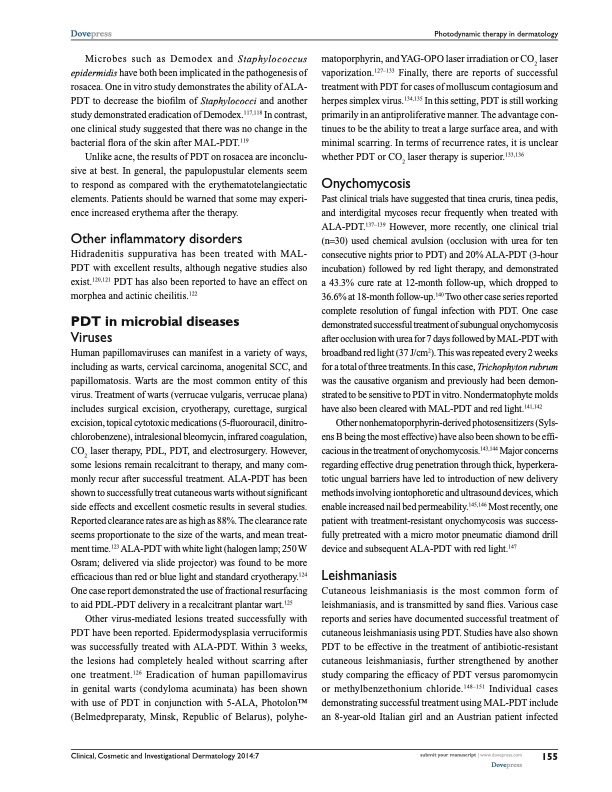
PDF Publication Title:
Text from PDF Page: 012
Dovepress Photodynamic therapy in dermatology Microbes such as Demodex and Staphylococcus epidermidis have both been implicated in the pathogenesis of rosacea. One in vitro study demonstrates the ability of ALA- PDT to decrease the biofilm of Staphylococci and another study demonstrated eradication of Demodex.117,118 In contrast, one clinical study suggested that there was no change in the bacterial flora of the skin after MAL-PDT.119 Unlike acne, the results of PDT on rosacea are inconclu- sive at best. In general, the papulopustular elements seem to respond as compared with the erythematotelangiectatic elements. Patients should be warned that some may experi- ence increased erythema after the therapy. Other inflammatory disorders Hidradenitis suppurativa has been treated with MAL- PDT with excellent results, although negative studies also exist.120,121 PDT has also been reported to have an effect on morphea and actinic cheilitis.122 PDT in microbial diseases viruses Human papillomaviruses can manifest in a variety of ways, including as warts, cervical carcinoma, anogenital SCC, and papillomatosis. Warts are the most common entity of this virus. Treatment of warts (verrucae vulgaris, verrucae plana) includes surgical excision, cryotherapy, curettage, surgical excision, topical cytotoxic medications (5-fluorouracil, dinitro- chlorobenzene), intralesional bleomycin, infrared coagulation, CO laser therapy, PDL, PDT, and electrosurgery. However, 2 some lesions remain recalcitrant to therapy, and many com- monly recur after successful treatment. ALA-PDT has been shown to successfully treat cutaneous warts without significant side effects and excellent cosmetic results in several studies. Reported clearance rates are as high as 88%. The clearance rate seems proportionate to the size of the warts, and mean treat- ment time.123 ALA-PDT with white light (halogen lamp; 250 W Osram; delivered via slide projector) was found to be more efficacious than red or blue light and standard cryotherapy.124 One case report demonstrated the use of fractional resurfacing to aid PDL-PDT delivery in a recalcitrant plantar wart.125 Other virus-mediated lesions treated successfully with PDT have been reported. Epidermodysplasia verruciformis was successfully treated with ALA-PDT. Within 3 weeks, the lesions had completely healed without scarring after one treatment.126 Eradication of human papillomavirus in genital warts (condyloma acuminata) has been shown with use of PDT in conjunction with 5-ALA, PhotolonTM (Belmedpreparaty, Minsk, Republic of Belarus), polyhe- Clinical, Cosmetic and Investigational Dermatology 2014:7 matoporphyrin, and YAG-OPO laser irradiation or CO2 laser vaporization.127–133 Finally, there are reports of successful treatment with PDT for cases of molluscum contagiosum and herpes simplex virus.134,135 In this setting, PDT is still working primarily in an antiproliferative manner. The advantage con- tinues to be the ability to treat a large surface area, and with minimal scarring. In terms of recurrence rates, it is unclear whether PDT or CO laser therapy is superior.133,136 2 Onychomycosis Past clinical trials have suggested that tinea cruris, tinea pedis, and interdigital mycoses recur frequently when treated with ALA-PDT.137–139 However, more recently, one clinical trial (n=30) used chemical avulsion (occlusion with urea for ten consecutive nights prior to PDT) and 20% ALA-PDT (3-hour incubation) followed by red light therapy, and demonstrated a 43.3% cure rate at 12-month follow-up, which dropped to 36.6% at 18-month follow-up.140 Two other case series reported complete resolution of fungal infection with PDT. One case demonstrated successful treatment of subungual onychomycosis after occlusion with urea for 7 days followed by MAL-PDT with broadband red light (37 J/cm2). This was repeated every 2 weeks for a total of three treatments. In this case, Trichophyton rubrum was the causative organism and previously had been demon- strated to be sensitive to PDT in vitro. Nondermatophyte molds have also been cleared with MAL-PDT and red light.141,142 Other nonhematoporphyrin-derived photosensitizers (Syls- ens B being the most effective) have also been shown to be effi- cacious in the treatment of onychomycosis.143,144 Major concerns regarding effective drug penetration through thick, hyperkera- totic ungual barriers have led to introduction of new delivery methods involving iontophoretic and ultrasound devices, which enable increased nail bed permeability.145,146 Most recently, one patient with treatment-resistant onychomycosis was success- fully pretreated with a micro motor pneumatic diamond drill device and subsequent ALA-PDT with red light.147 Leishmaniasis Cutaneous leishmaniasis is the most common form of leishmaniasis, and is transmitted by sand flies. Various case reports and series have documented successful treatment of cutaneous leishmaniasis using PDT. Studies have also shown PDT to be effective in the treatment of antibiotic-resistant cutaneous leishmaniasis, further strengthened by another study comparing the efficacy of PDT versus paromomycin or methylbenzethonium chloride.148–151 Individual cases demonstrating successful treatment using MAL-PDT include an 8-year-old Italian girl and an Austrian patient infected submit your manuscript | www.dovepress.com Dovepress 155PDF Image | applications of photodynamic therapy dermatology

PDF Search Title:
applications of photodynamic therapy dermatologyOriginal File Name Searched:
photodynamic-therapy-dermatology.pdfDIY PDF Search: Google It | Yahoo | Bing
Cruise Ship Reviews | Luxury Resort | Jet | Yacht | and Travel Tech More Info
Cruising Review Topics and Articles More Info
Software based on Filemaker for the travel industry More Info
The Burgenstock Resort: Reviews on CruisingReview website... More Info
Resort Reviews: World Class resorts... More Info
The Riffelalp Resort: Reviews on CruisingReview website... More Info
| CONTACT TEL: 608-238-6001 Email: greg@cruisingreview.com | RSS | AMP |